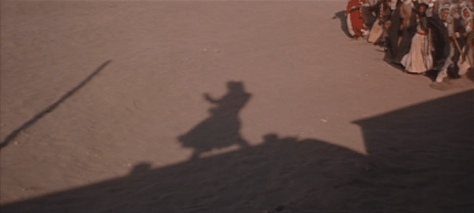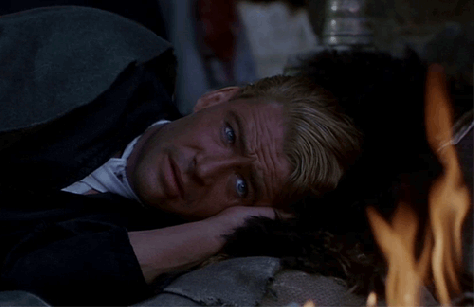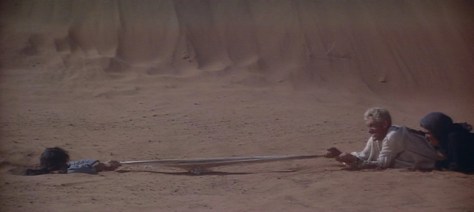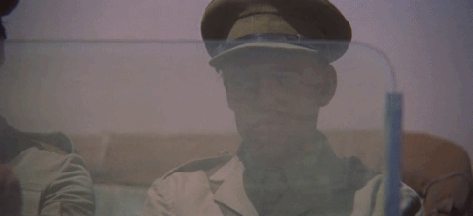Our Take Two column offers second opinions and alternative angles on films and TV series reviewed elsewhere on Motion State. Head here for our Face Off between Lawrence of Arabia and Queen of the Desert.
David Lean’s T. E. Lawrence film is a visual adventure boasting some of the most impressive and ingenious staging you’ll ever see. One might be tempted to test Steven Soderbergh’s theory on the removal of sound and color from Raiders of the Lost Ark, an exercise meant to highlight how well Spielberg’s film is staged and framed, although sitting through a soundless black-and-white version of the nearly four-hour Lawrence of Arabia seems an especially colossal task. So, instead, we’ll examine here a few of the visual cues that drive Lawrence the film and inform Lawrence the character, and in so doing might uncover what Lean’s epic has to say about the explorer’s fabled legacy.
One would be remiss to announce a discussion of the visuals of Lawrence of Arabia without beginning at the most famous smash cut of the film, one of the most famous smash cuts of any film:

This is how Lawrence gets to Arabia. Due respect to the Old-West-to-South-America-via-NYC montage of Butch Cassidy and the Sundance Kid, but in Lawrence the journey to Arabia is not as significant as the journey in Arabia; but Lean’s matching of the two images does more than save time. There’s an ever-so-slight grin that Lawrence gives just before he extinguishes the match, enough to suggest a truth that he knows and we do not. Fire is one of the primary visual symbols of the film, and in retrospect the correlation between Lawrence’s ego and the story told by that single cut is highly revealing.
The desert, after all, is compared again and again to fire. “Lawrence,” advises the politician Dryden, “only two kinds of creature get fun in the desert: Bedouins and gods, and you’re neither. Take it from me, for ordinary men, it’s a burning, fiery furnace.” Lawrence, of course, shrugs this off (“No…it’s going to be fun”); that’s slightly more indifference than the real T. E. Lawrence managed, who wrote in his memoir Seven Pillars of Wisdom that “the heat of Arabia came out like a drawn sword and struck us speechless.” The further implication of Dryden’s statement is that Lawrence may in fact not be just an ordinary man, and thus does his self-inflated stature grow in the face of the vast and fiery desert. That smash cut presages this: Lawrence grins and makes smoke of the fire as if to assert his place as an extraordinary man, or as a god. The expanse of red-orange sky looks a bit more dangerous than the match, though, doesn’t it?
Lawrence’s ego is then tied to the image of his shadow, which seems a kind of surrogate for his aura or legend, extending as the sun elongates his contour in the sand. The opening shots/credits of the film depict the short shadows of Lawrence and his motorbike:

Ali’s introduction, too, is via shadow:

In the second instance it’s as if Lawrence sees the man’s aura, not the man, encountering strangers by their power instead of by their personality. When Lawrence first dons the keffiyeh of the people that will come to respect him as a leader, he seeks his reflection in the blade of his knife:

…but then he finds his own shadow to be a more accurate representation:

And the link between the image of the shadow and Lawrence’s legend/ego is made explicit in the train-sacking scene, when Lawrence alights upon the overturned steam engine and marches along it like an explorer along a mountain range. The Arabs below? They don’t follow Lawrence — they follow his shadow:

“Do you think I’m just anybody, Ali?” There’s no doubt that the man himself recognizes T. E. Lawrence as an extraordinary man, and that’s true of both Lawrence of Arabia and, to a slightly more inscrutable degree, the actual Lawrence. In the film General Allenby exclaims “I believe your name will be a household word when you’ll have to go to the War Museum to find who Allenby was. You’re the most extraordinary man I’ve ever met!” In Seven Pillars, Lawrence provides a further angle on that outside point of view: “Allenby could not make out how much was genuine performer and how much charlatan. The problem was working behind his eyes, and I left him unhelped to solve it.”
But the legacy of Lawrence is more fable than legend, more myth than fact, and more malleable than historical record suggests. To some, the fable is one of greatness: Winston Churchill eulogized Lawrence as “one of the greatest beings alive in our time. I do not see his like elsewhere. I fear whatever our need we shall never see his like again.” To others, Lawrence was indeed more charlatan than noble hero: Sheik Khaled Suleiman al-Atoun admitted to Smithsonian columnist Scott Anderson that “some people think [Lawrence] was really trying to help the Arabs, but others think it was a trick, that Lawrence was actually working for the British Empire all along…Some of the very old ones still believe he was a friend of the Arabs, but everyone else, we know the truth. Even my grandfather, before he died, he believed he had been tricked.”
Perhaps when the cinematic version of Lawrence purposefully snuffs out little flames and gazes inquisitively at his own shadow he’s trying to determine where his legacy will fall. Perhaps when he asserts his fable as the stuff of legend — “I know I’m not ordinary…All right! I’m extraordinary!” — he’s not as certain as he seems.

It’s Auda who sees this most clearly at the end of Lawrence of Arabia, and it’s his perception of Lawrence’s fable that seems to persist in Lawrence’s mind, in Lean’s, and in ours. The imagery of sand is a surprisingly subtle one throughout the film, more prevalent and thus more unexpected as a symbol rather than a setting. Time and again Lawrence emerges from a sandstorm that had previously eclipsed his entire figure, or he’s barely visible as he plods through a vast desert landscape. He’s nearly swallowed by the desert — and in some sense he actually is.
“The desert has dried up more blood than you can think of,” says Auda, “…you will return. There is only the desert for you.” This is the response to Lawrence’s express desire to “never see the desert again”, a part of his realization that his conflicted loyalties and miraculous victories and enduring legacy are all at the mercy of history. The sand of the desert is the symbol of history. For a figure like Lawrence, his shadow might extend for miles over the platform of desert, the platform of history; that same platform gives way for others, literally swallowing one of Lawrence’s young aides (which he takes responsibility for, saying “I led him into quicksand” and recognizing his failure to prevent it from happening):

Lawrence of Arabia ends on that question of whether T. E. Lawrence has in fact been devoured by history, of whether anyone can be so extraordinary as to not be devoured by history. In the last shot Lawrence’s visage, the face someday carved in hardened stone at St. Paul’s Cathedral, is blurred by the sand on the windscreen:

To Lawrence himself, both fire and shadow represent his place in the world: he looks to the darkened silhouette in the sunlight and to the flickering firelight in the darkness. To us, the enormous dunes and swirling vortexes of swept-up desert are infinitely more powerful. The fable of T. E. Lawrence is a changing and malleable account — it’s increasingly difficult to match up modern accounts or overviews of his life from Military History with speculations on what his foreign policy would be on today’s volatile Islamic State or with opinions on his contributions from the Arab perspective. From 2000 to 2010 alone, more than twenty new books on Lawrence were published. The aforementioned Smithsonian article carefully takes Lawrence’s legacy into account, and Lawrence of Arabia does, too, in a far more imaginative manner. In the film Lawrence asserts and truly believes that “Nothing is written” — but his legend is, and it’s written in dying flame, in fleeting shadow, in stretches of sand that never stop shifting.


I would like to use your gif of Lawrence observing his shadow in my blog An Amateur’s Journey Through the Bible http://bikingfencer.blogspot.com.
LikeLike
Great post thannk you
LikeLike